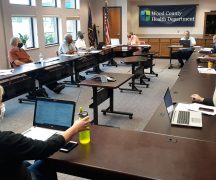By JAN LARSON McLAUGHLIN
BG Independent News
Wood County’s overall health issues can’t be fixed with a 5K race, informational pamphlets, or cleverly-worded T-shirts.
“We’re talking about a culture shift – not just one-time events,” said Wood County Health Commissioner Ben Robison.
Behavior changes are needed to improve the health of Wood Countians, according to the recently released Community Health Improvement Plan. The CHIP sets priorities and assigns work to various community partners.
“We’re not just improving health. We’re improving the community overall,” Robison said during a meeting on the CHIP. “This is all of us coming together to make a joint investment.”
Last spring, officials from Wood County Health Department and Wood County Hospital presented results of a Community Health Assessment. The report offered a “snapshot” of Wood County’s health that was not all rosy.
Obesity is up. Binge drinking has increased.
Mental health issues are mounting in all age groups. People are reporting having more bad mental health days, and more youth reported seriously considering suicide. Meanwhile, the number of mental health providers serving the region is lacking.
“We don’t have enough mental health professionals,” Robison said.
And residents with very low annual incomes have worse outcomes across all areas of health. Approximately 13.3% of Wood County residents were below the poverty line, according to the 2014-2018 American Community Survey five-year estimates. The report looks at the impact of reduced income on health status.
The fact is that wealthier populations are healthier, Robison said. The healthiest county in Ohio – Delaware – is also the county where residents have the highest incomes.
“We want to understand the impacts of poverty,” Robison said.
Some systemic issues affecting health include housing, transportation, access to care, support for mental health, and awareness of adverse childhood experiences.
The Wood County Community Health Assessment is conducted every three years by the Wood County Health Department and Wood County Hospital to analyze health trends and identify health needs. The finished report is more than 150 pages.
The surveys were mailed out to 2,000 adults and 5,000 parents of children under age 12 – along with $2 bills as an incentive for local residents to fill them out and mail them back. The youth surveys were conducted in sixth through 12th grades in local schools.
The results are intended to help health partners in the county set “aspirational goals that are realistic,” Robison said.
Based on the health assessment, 27 key issues were identified by the Wood County Health Partners.
For adults those issues are: alcohol consumption, cardiovascular disease, diabetes, drug use, food insecurity, mental health, oral health, physical activity, prenatal care, social determinants of health, tobacco use, transportation, weight status, poverty, and sexual violence.
For youth, the issues include: alcohol consumption, drug use, mental health, poverty, social determinants of health, tobacco/vaping, violence and bullying, and weight status.
And for children, the key issues are: bullying, health conditions, poverty, social determinants of health, and weight status.
In addition to the health department and hospital, the plan’s development includes participation of a broad set of community stakeholders and partners. Those include United Way of Wood County, Children’s Resource Center, Wood County Educational Services Center, Great Lakes Community Action Partnership, Wood County Job and Family Services SNAP, BGSU, Wood County Park District, and Wood County Alcohol Drug Addiction and Mental Health Services.
The CHIP addresses the following priority areas and strategies:
COMMUNITY CONDITIONS
Community conditions refer to those factors that are outside the health care system that impact the collective health and well-being of people in the community. Many of these factors are related to socio-economic status, such as income levels, nutrition, crime and transportation resources
Expand and improve housing options for residents of Wood County
- Increase public awareness of affordable housing options available by providing a comprehensive guide to available housing resources.
- Advocate for expansion of affordable housing programs for the lowest income renters.
- Advocate for zoning and housing policies to expand areas where affordable housing can be built.
- Expand available transitional housing options that provide transitional housing for six to 24 months.
Increase awareness, identification and intervention for Adverse Childhood Experiences
- Survey health care providers, teachers, coaches, social service providers and other community members on their awareness and use of trauma-informed care, including toxic stress and ACEs.
- Develop materials on ACEs that can be used by agencies to mitigate their impact on the people they serve.
- Train teachers, superintendents and organizations that work with people with ACEs on trauma-informed care.
Strengthen public transportation to make it more accessible to more people in more places and for more purposes
- Continue to increase the public awareness of all transportation options through marketing.
- Expand coordination for public transportation with adjoining counties.
- Increase funding for the NET Plus Program in Wood County.
- Seek an increase in funding for transportation providers who serve seniors, individuals with disabilities and low-income individuals.
HEALTH BEHAVIORS
Health behaviors are actions people take that affect their health. They include behaviors that lead to improved health, such as eating well and being physically active, and behaviors that increase one’s risk of disease, such as smoking.
Reduce nicotine use among Wood County residents
- Mass media campaigns against tobacco use.
- Smoke-free policies for indoor/outdoor areas.
- Tobacco cessation therapy affordability.
Increase the number of Wood County residents who have access to and regularly eat nutritious foods
- Food insecurity screening program.
- Health food initiatives in food banks.
- School-based nutrition education programs.
Increase the number of hours Wood County residents engage in regular physical activity
- Community-wide physical activity campaign.
- Safe Routes to Schools programs.
- Exercise prescriptions from healthcare providers.
- Increase access to free/affordable opportunities for exercise.
- Policies to promote physical activity at work and school.
ACCESS TO CARE and CHRONIC DISEASE
Access to affordable, quality and timely health care can help prevent diseases and detect issues sooner, enabling people to live longer, healthier lives. People encounter a variety of barriers in attempting to access care, and access can vary based on factors such as geography, race and ethnicity, and income.
Chronic diseases like diabetes, heart disease and cancer take a significant toll on public health. Yet many chronic diseases are preventable. Strategies in the area aim to reduce people’s risk factors by promoting physical activity, improving access to healthy and affordable foods, and expanding access to tobacco cessation information and programs.
Increase the number of individuals who receive recommended medical care
- Identify barriers and gaps in accessing healthcare services.
- Raise awareness of importance of seeing a primary care provider annually, engage in preventative care, how to lower risks for chronic disease, importance of hypertension and diabetes screenings and follow up, importance of prenatal and postpartum care.
Increase the number of individuals who receive recommended dental care
- Improve awareness of the benefits of routine dental care.
- Create and maintain a database of local resources to help people find low-cost providers.
Develop a multi-year plan to increase the number of mental health professionals available to serve Wood County residents
- Telehealth services for mental health.
- Raise awareness of benefits of mental health services.
- School-based counseling services.
- Develop and publish a Mental Health Resource Guide.
MENTAL HEALTH AND ADDICTION
Ensuring that individuals have access to mental health care can improve lives and communities. For many, it can dramatically reduce or eliminate the risk of suicide, legal issues, family conflict, employment issues, substance abuse and further mental and physical health problems.
Develop a multi-year plan to increase the number of mental health professionals available to serve Wood County residents
Increase care-seeking behavior for mental health among Wood County residents
- Implement “stigma-free workplace” program in area businesses.
- Develop and launch a communication campaign to make people aware of when they should seek care, and normalize seeking care.
SOCIAL WELLNESS
This priority is focused on increasing the individual well-being of Wood County residents, including increasing the sense of community connectedness, and knowledge and resources.
Increase individual well-being among Wood County residents, including opportunities that enhance self-care
- Research strategies demonstrated to improve aspects of health, such as sleep, reduced screen time, healthy social interactions, happiness, reducing chronic pain, families sharing meals together, reading to kids, etc.
- Compile list/overview of free and low-cost resources available for self-care that are available to residents.
- Enhance and expand “No Wrong Door” resources and training to include opportunities for self-care.
- Develop programs to implement across multiple organizations – schools, churches, businesses, etc.
- Community education about the importance of self-care.
- Advocate for policies that promote self-care.
——————————————————————-
Following are some of the results of the Wood County Community Health Assessment released in March of 2022:
ADULT RESPONSES
Health care access
- 93% of adults had health care coverage.
- Top reasons adults were without coverage included losing a job or changing employers, or the employer did not or stopped offering coverage.
Health behaviors
- 69% of adults were either overweight (32%) or obese (37%).
- 47% of adults were trying to lose weight.
- 10% of adults were current smokers.
- 21% were former smokers.
- 36% of adults reported being binge drinkers.
- 9% of adults had used recreational marijuana in the past six months, increasing to 22% of those under age 30.
- 5% of adults had used a medication not prescribed for them, or took more than prescribed amount to feel good or high, or to be more active or alert in the last six months. That increased to 11% for those with annual incomes under $25,000.
- 76% of adults had sexual intercourse in the past year. Only 1% reported having intercourse with more than one partner in the past year.
Mental health
- 3% of adults reported attempting suicide in the past year.
- Adults indicated the following caused them anxiety, stress or depression: Current world events or political environment (49%), job stress (48%), COVID-19 pandemic (46%), financial stress (37%), death of close family member or friend (22%), social media (16%), marital/dating relationship (16%), other stress at home (16%), poverty/no money (15%), sick family member (13%).
Chronic disease
- 30% of adults were diagnosed with high blood pressure or high cholesterol.
- 11% of adults were diagnosed with cancer at some point in their lives, increasing to 28% of those over age 65.
- 31% of adults had been diagnosed with arthritis.
- 10% of adults had been diagnosed with asthma.
- 8% of adults were diagnosed with diabetes, increasing to 20% of those over age 65.
Social determinants of health
- 13% of adults needed help meeting their general daily needs such as food, clothing, shelter or paying utility bills in the past month.
- 17% of adults had transportation issues.
YOUTH RESPONSES
Weight status
- 31% of youth were either overweight (13%) or obese (18%)
- 40% of youth were trying to lose weight, increasing to 52% of females.
- 10% of youth did not participate in at least an hour of physical activity on any day in the past week.
- 22% of youth spent three or more hours playing video games on an average school day.
Tobacco use
- 8% of all Wood County youth had tried cigarette smoking, increasing to 20% of those 17 and older.
- 3% had tried cigarette smoking for the first time before age 13.
- 2% were current smokers.
Alcohol consumption
- 28% of youth had at least one drink of alcohol in their life, increasing to 53% of those 17 and older.
- 11% of youth had at least one drink in the past month, increasing to 27% for those 17 and older.
- 5% of youth were considered binge drinkers, increasing to 20% for ages 17 and older.
- Youth drinkers reported they got alcohol from the following: Someone gave it to them (42%), someone older bought it (32%), a parent gave it to them (29%), took it from a store or family member (24%), an older friend or sibling bought it (13%), a friend’s parent gave it to them (13%), bought it with fake ID (8%).
Drug use
- 5% of youth had used marijuana at least once in the past 30 days, increasing to 18% for those 17 and older.
- 3% used medications that were not prescribed for them, or took more than prescribed to feel good or get high. That number increased to 5% for those over age 17.
Mental health
- 29% of youth reported they felt so sad or hopeless almost every day for two weeks or more in a row, that they stopped doing some usual activities. That number increased to 36% for females.
- 14% reported they had seriously considered attempting suicide in the past year.
- 5% of Wood County youth had attempted suicide in the past year.
- Wood County youth reported the following caused them anxiety, stress or depression: Academic success (48%), self image (36%), sports (33%), fighting with friends (30%), death of a close family member or friend (27%), peer pressure (26%), other stress at home (24%), COVID-19 (24%), fighting at home (20%), social media (18%)
Social determinants of health
- 72% of youth had been to the doctor for a routine check up in the past year.
- 78% reported they saw a dentist in the past year.
- 39% got eight or more hours of sleep on an average school night; 36% got six hours or less.
- 3% reported they went to bed hungry because their family did not have enough money for food at least one night per week; 1% went to bed hungry every night of the week.
- 2% experienced financial trouble due to gambling.
- 6% prioritized gaming over other daily activities; 6% continued gaming despite negative consequences; 4% had difficulties controlling their gaming.
- Youth reported the following childhood adverse experiences: Parents separated or divorced (27%), adults in the home swore at them and put them down (22%), lived with someone who was depressed or mentally ill (17%), parents not married (15%), family did not look out for each other (12%), lived with someone who is a problem drinker (12%), lived with someone who served time or was sentenced to serve time in prison or jail (10%), lived with someone who used drugs illegally (7%), adults in the home abused each other (6%), adults in the home abused them (5%), did not have enough to eat, had to wear dirty clothes and had no one to protect them (5%).
Violence
- 8% of youth carried a weapon (gun, knife or club) in the past 30 days.
- 20% of youth had purposely hurt themselves: Scratching (14%), cutting (11%), hitting (11%), biting (7%), burning (3%), and self-embedding (2%).
- 15% of youth had been involved in a physical fight.
- 30% of youth had been bullied in the past year: Verbally (21%), indirectly (18%), cyber (10%), physically (4%), and sexually (3%).
CHILD RESULTS
General health
- 98% of parents rated their child’s health as excellent or very good.
- 78% of children had been to the dentist in the past year, increasing to 90% of 6-11-year-olds.
Weight and nutrition
- 21% of children were classified as obese by BMI calculations; 12% were classified as overweight; 59% were normal weight; 8% were underweight.
- 26% of children ate five or more servings of fruit and vegetables per day.
Health conditions
- Parents were told by a doctor that their child had the following conditions: 11% anxiety problems, 8% speech and language delays, 8% ADD/ADHD, 4% learning disability, 4% developmental delay, 3% overweight/obese, 3% behavioral problem, 2% autism, 2% depression.
Health insurance and use
- 3% of parents reported their child did not currently have health insurance.
- 91% of children had received all their recommended vaccinations.
Early childhood (ages 0-5)
- Parents reported on places they put their children to sleep, with 94% saying a crib/bassinet without bumper, blankets or stuffed animals – to prevent SIDS.
- Mothers breastfed their babies less than three months (21%), four to six months (10%), seven to nine months (10%), 10 to 12 months (20%), more than one year (21%), still breastfeeding (6%), never breastfed (12%)
- 60% of parents reported they or a family member read to their child every day in the past week.
Middle childhood (ages 6-11)
- 85% of parents reported their child was physically active for at least an hour on three or more days in the past week.
- 30% of parents reported their child was bullied in the past year.
- The following top five topics were discussed by parents with their 6-11-year-olds: Screen time (86%), eating habits (71%), bullying/violence (62%), cyber/internet safety (55%), and body image (41%).
Family functioning
- 43% of parents reported that every family member who lived in their household ate a meal together every day of the week. Families ate together an average of 5.3 times per week.
- 2% of parents reported that at least one person in the household went to bed hungry at least one day per week because they did not have enough money for food.
- 67% of parents reported they felt they handled day-to-day demands of raising children very well.
- Parents reported their child experienced the following adverse childhood experiences: Parents separated or divorced (13%), lived with someone who was mentally ill, suicidal or severely depressed (5%), lived with someone who had a problem with alcohol or drugs (3%), lived with a parent or guardian who served time in jail (2%).
Neighborhood characteristics
- 99% of parents definitely or somewhat agreed their child was safe in their neighborhood.
- In the past week, parents reported they visited their local park/bike trails with their child: One time (34%), two-three times (32%), four or more times (7%).
- 9% of children have moved to a new address three or more times; 31% moved one time; 10% moved two times; 50% had never moved.
Home environment characteristics
- Parents reported having the following safety items in their home: Working smoke alarm (99%), carbon monoxide detector (84%), fire extinguisher (73%).
- Parents had the following rules about smoking or vaping: No one allowed to smoke or vape in the car (85%), no one allowed to smoke or vape in home (69%).
COVID-19
- Families were negatively affected by COVID-19 pandemic in the following ways: Educational challenges (34%), change in mental health (22%), lack of childcare (14%), change in employment status (12%) change in physical health (9%), loss of household income (9%).





